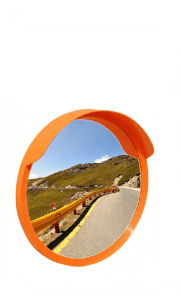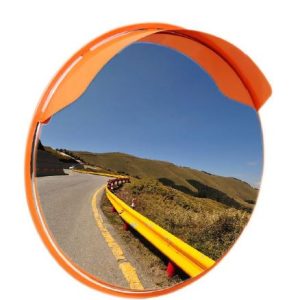Security Mirror
Security System
Door Access System
Others
A convex mirror, otherwise known as a safety mirror, has a reflective surface that curves outward, towards the light source. The outward bulge or curve of the mirror expands the visible field presented in the mirror reflection, causing the image of an object to appear larger as it approaches the mirror. This makes convex mirrors ideal for eliminating blind spots, boosting the security of a property or lowering the risk of collisions in specific traffic areas.






Convex mirrors are a simple and effective way to improve the safety and security of your property. Often, these mirrors are mounted to a wall or ceiling at points with low visibility, particularly where a hallway or traffic intersects. These installations remove blind spots and provide everyone with an excellent overview of their surroundings.
These benefits are crucial in an environment where heavy machinery is required for daily operations, such as a warehouse. The convex mirrors can be situated at crossings to enable your workers to spot any approaching forklifts, or in the case of the forklift driver, an approaching colleague. This minimises the risk of workplace accidents.
Convex mirrors are also an essential security tool in places with bustling traffic like the parking facilities of a commercial building. By installing a convex mirror, you provide motorists with an additional set of eyes to spot oncoming vehicles or pedestrians at a blind corner
Convex mirrors are a simple and effective way to improve the safety and security of your property. Often, these mirrors are mounted to a wall or ceiling at points with low visibility, particularly where a hallway or traffic intersects. These installations remove blind spots and provide everyone with an excellent overview of their surroundings.
These benefits are crucial in an environment where heavy machinery is required for daily operations, such as a warehouse. The convex mirrors can be situated at crossings to enable your workers to spot any approaching forklifts, or in the case of the forklift driver, an approaching colleague. This minimises the risk of workplace accidents.
Convex mirrors are also an essential security tool in places with bustling traffic like the parking facilities of a commercial building. By installing a convex mirror, you provide motorists with an additional set of eyes to spot oncoming vehicles or pedestrians at a blind corner
Cost-efficient and long-lasting: As convex mirrors may be installed outdoors, withstanding the elements is key. Therefore, they are typically manufactured from lightweight and durable materials such as acrylic, polycarbonate, or stainless steel.
This means convex mirrors require little to no maintenance. Furthermore, they are easy to set up and do not require skilled labour. Once the mirrors are installed, security is significantly enhanced at a minimal cost.
Complements your existing security system: CCTV surveillance systems are an excellent security tool to safeguard your property and deter intruders. However, depending on your CCTV camera model, there may be areas and corners that are not covered by your existing surveillance system.
By installing convex mirrors on your property and strategically placing them at these blind spots, you can increase the field of view over the monitored area. This ensures that you do not overlook any spots which can be exploited by intruders.
Enhance traffic flow: Given the limited land space available in Singapore, traffic congestion is common, especially during peak travel hours. To alleviate this issue, you can consider installing convex mirrors to improve the traffic flow in and around your property. This will help prevent unnecessary congestion and inconvenience.
Glass
Traditional convex mirrors are often made from glass. Glass convex mirrors are durable and provide clear, distortion-free reflections. They are commonly used for traffic safety, security, and industrial applications due to their resilience and optical quality.
Acrylic (Polycarbonate)
In some cases, convex mirrors are constructed using acrylic or polycarbonate materials. These materials are lightweight, shatter-resistant, and less likely to break than glass. Acrylic convex mirrors are often used in indoor environments, such as retail stores and warehouses, where safety and durability are essential.
Metal-Coated Substrates
Convex mirrors can also be made by applying a reflective metal coating, such as aluminium or chrome, onto a curved substrate. The substrate material can vary, but it’s often plastic or fibreglass. These mirrors are lightweight and can be suitable for outdoor use, particularly in situations where weight needs to be minimised.
Selecting the right size of a convex mirror is essential to ensure it serves its intended purpose effectively. To make an informed decision, consider several factors. First, determine the viewing distance from the mirror to the area you want to monitor. A larger mirror is necessary for longer distances to maintain visibility. Second, assess the size of the area you want the mirror to cover, ensuring it provides a wide enough field of view without distortion. Lastly, consider the surrounding environment, such as the available mounting space and potential obstructions. By carefully evaluating these aspects, you can choose the perfect size of a convex mirror that enhances safety, security, and visibility in your specific application.
Convex mirrors are primarily used for improving visibility and safety. They are commonly employed in traffic management, parking lots, driveways, and blind spots to enhance awareness and minimise accidents. Additionally, they find applications in retail stores, warehouses, and factories for surveillance and security purposes.
Convex mirrors are curved outward, which causes light rays to diverge upon hitting the surface. This divergence results in a wider field of view, but objects appear smaller and farther away than they actually are. The curvature of the mirror allows for a broader perspective, making it suitable for areas where it’s essential to see a larger area in a single glance.
Convex mirrors curve outward and reflect light outwards, creating a wider field of view and reducing image size. In contrast, concave mirrors curve inward and can either converge or diverge light, producing either enlarged or reduced images, depending on their use. Convex mirrors are primarily for safety and surveillance, while concave mirrors are used in various optical applications, such as telescopes and makeup mirrors.
Yes, convex mirrors do create a distorted image of objects reflected in them. Objects appear smaller and farther away than they actually are. However, this distortion is intentional and is what allows convex mirrors to provide a wider field of view, making them suitable for applications where a broader perspective is more critical than precise detail.
Convex mirrors are primarily used for improving visibility and safety. They are commonly employed in traffic management, parking lots, driveways, and blind spots to enhance awareness and minimise accidents. Additionally, they find applications in retail stores, warehouses, and factories for surveillance and security purposes.
Convex mirrors are curved outward, which causes light rays to diverge upon hitting the surface. This divergence results in a wider field of view, but objects appear smaller and farther away than they actually are. The curvature of the mirror allows for a broader perspective, making it suitable for areas where it’s essential to see a larger area in a single glance.
Convex mirrors curve outward and reflect light outwards, creating a wider field of view and reducing image size. In contrast, concave mirrors curve inward and can either converge or diverge light, producing either enlarged or reduced images, depending on their use. Convex mirrors are primarily for safety and surveillance, while concave mirrors are used in various optical applications, such as telescopes and makeup mirrors.
Yes, convex mirrors do create a distorted image of objects reflected in them. Objects appear smaller and farther away than they actually are. However, this distortion is intentional and is what allows convex mirrors to provide a wider field of view, making them suitable for applications where a broader perspective is more critical than precise detail.
Quick Links: